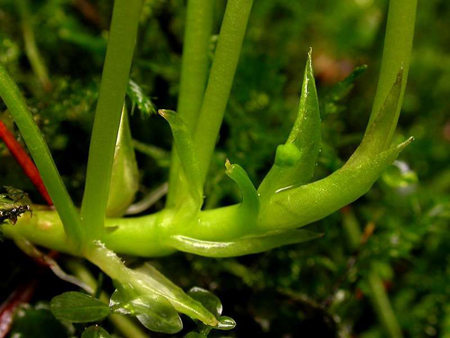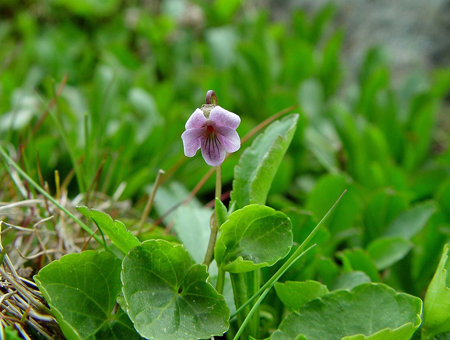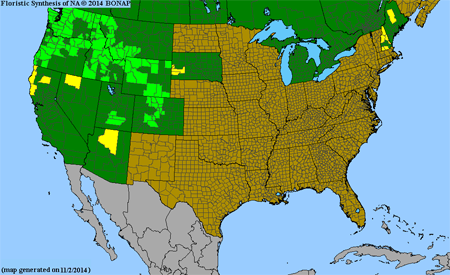Viola palustris L.
Common names:
Northern Marsh Violet
Synonyms:
Viola palustris L., Sp. pl., ed. 1, 2: 934. 1753. "Habitat in Europae frigidioris paludibus." TYPE: "Habitat in Europae frigidioris paludibus" (LECTOTYPE (designated by Jonsell & Jarvis, Nordic J. Bot. 22 : 82. 2002): Herb. Linn. No. 278 (LAPP)).
Viola palustris L. subsp. typica M.S.Baker, Madroño 3: 235. 1936 [nomen invalidum]
Viola palustris L. var. leimonia J.K.Henry, Fl. s. Brit. Columbia: 207. 1915
Viola palustris L. var. pensylvanica Ging., in DC., Prodr. 1: 294. 1824
Viola macloskeyi F.E.Lloyd var. pallens (Banks ex Ging.) C.L.Hitchc., Vasc. Pl. Pacific NorthW. 3: 445. 1961; Viola macloskeyi F.E.Lloyd subsp. pallens (Banks ex Ging.) M.S.Baker, Madroño 12: 60. 1953; Viola pallens (Banks ex Ging.) Brainerd, Rhodora 7: 247. 1905; Viola rotundifolia Michx. var. pallens Banks ex Ging., in DC., Prodr. 1: 295. 1824. TYPE: Canada, Newfoundland and Labrador, 1766, J. Banks s.n. (LECTOTYPE (designated by Ballard Jr., H. E., D. A. Casamatta, M. M. Hall, R. A. McCauley, M. C. Segovia-Salcedo, and R. G. Verb, Brittonia 53(1): 131. 2001): BM000617600, internet image!)
Description:
Acaulescent stoloniferous perennials, colonial from slender creeping rhizome and lateral stolons, leaves, flowers and fruits inserted separately along rhizome near apex, stolons surficial, produced in summer with leaves and cleistogamous flowers and fruits, ≤ 15 cm tall; foliage and peduncles gray-green, strictly glabrous; leaves 2–5 during chasmogamous flower, spreading; stipules free, brownish, irregularly glandular-fimbriate; leaf blades undivided, largest ≤ 70 × 41 mm during fruit, round-reniform to reniform, base cordate, margins subentire to pronouncedly crenate, eciliate, apex subobtuse to rounded; chasmogamous peduncle held among or above the leaves; bracts positioned at or below the middle of the peduncle; chasmogamous flower ≤ 16 mm; calyx glabrous, eciliate; lowest sepals ovate-lanceolate, rounded; auricles short and rounded, not elongating in fruit; corolla whitish or pink-mauve, throat greenish-white; spur short-globose, ca. 2.0 mm long, 1.5 × as long as auricles; all petals glabrous within; style and stamen appendages weakly exserted and scarcely visible in life; cleistogamous flowers produced after chasmogamous, on ascending or erect peduncle shorter than or surpassing petioles; capsule 5–8 mm, green drying tan, unspotted or with fine red spots, glabrous; seeds ca. 1.7 × 1.0 mm, very dark brown to black, unspotted; 2n=48.
Similar species:
This species and V. suecica belong to the Palustres species group, sharing a creeping node-rooting rhizome with lateral stolons, leaves not forming a rhizome but inserted individually along the length of the rhizome nearer the apex, broad stipules, reniform leaf blades, and violet corollas. It differs most conspicuously from V. suecica in its strictly glabrous foliage, more numerous and larger leaves (at least during chasmogamous flower), bracts positioned at or below the middle of the peduncle, glabrous lateral petals, and darker unspotted seeds. In cleistogamous fruit, if the creeping rhizome with leaves inserted separately along its length are ignored, it can be distinguished from from V. incognita and V. renifolia by its subentire to crenate leaf blade margins, unspotted cleistogamous capsule, and dark unspotted seeds; and from V. minuscula by the proportionally broader strictly glabrous leaves, and larger unspotted seeds.
Ecology:
Alpine meadows, marshes, bogs and lakeshores.
Distribution:
Circumboreal, GL and NL to AK, south to ME, NH, w. SD and the Rocky Mountains; Eurasia.
Rarity:
State listed in NH.
Phenology:
Chasmogamous flower June–August, chasmogamous fruit July–August, cleistogamous fruit July–September.
Affinities:
This species belongs to the Acaulescent White Violet lineage, sect. Plagiostigma Godron, subsect. Stolonosae (Kupffer.) Kupffer, in the Palustres species group.
Hybrids:
Hybridizes with V. epipsila subsp. repens (Kim Blaxland, "Botanikim" website), and probably with V. minuscula based on herbarium specimens and indications by Haines et al. (2011). The latter hybrid should be sought and examined, as the two species grow intermingled in the zone of overlap, according to northeastern herbarium specimens and floras. Both hybrids would be roughly intermediate in characteristics of foliage and chasmogamous floral traits (or more similar to V. palustris but would presumably be utterly sterile as triploids, failing to reproduce by chasmogamous flowers and producing abortive cleistogamous capsules or normal capsules without viable seeds. Studies are needed to assess these predictions.
Comments:
Brainerd (1921b), Fernald (1950), Alexander (1963), Russell (1965), and Gleason and Cronquist (1991) recognized a broadly delimited V. palustris that explicitly or implicitly included V. epipsila (here treated as V. suecica). Brainerd Baird (1942), Jørgensen et al. (1958), Scoggan (1978), Ballard (1985, 1995), Haines et al. (2011), Little and McKinney (2015) maintained both as distinct species. White-flowered plants or populations found throughout the Rocky Mountain region of the West (particularly in the northern U.S. and adjacent Canada) were initially named V. palustris subsp. brevipes M.S.Baker. Clausen (1964) and Sorsa (1968) reported meiotic irregularities in plants matching Baker's description from the type locality in Colorado that indicated hybridization with another species or hybrid derivation, but morphologically the taxon was relatively stable and fertile. Scoggan and Haines treated the western white-flowered taxon as var. brevipes. Sorsa highlighted the taxonomic difficulties posed by an additional taxon in the Pacific Northwest coastal areas with an octoploid chromosome number like that of V. palustris but with certain morphological features similar to those of V. epipsila (= V. suecica). Marcussen et al. (2012) and Blaxland et al. (2018) demonstrated different evolutionary origins and morphological distinctions between the Pacific Northwest violet and V. palustris, and Blaxland et al. described Viola pluviae for the Pacific Northwest species.
During recent preparation of a worldwide classification of the genus Viola (Marcussen et al. 2022), Thomas Marcussen, Alexander Sennikov and Jiří Danihelka reexamined morphology, cytology and nuclear DNA content for the Palustres taxa worldwide. They recognized five distinct species consisting of V. epipsila sensu stricto in western Eurasia; V. palustris in Europe and eastern North America; V. suecica (including the names V. achyrophora, V. epipsiloides and V. epipsila subsp. repens) in Iceland and Siberia eastward through Beringia to central North America; V. pluviae in western coastal North America; and V. brevipes comb. ined. in the Rocky Mountains of western North America. They indicated that V. suecica is composed of two putative subspecies, subsp. suecica in Europe the other subspecies repens comb. ined. under V. suecica in North America. They are presently preparing a manuscript to elucidate the new taxonomic delimitations in the Palustres violets (Thomas Marcussen pers. comm.).
Viola palustris ranges across North America, reaching south into our region only in the White Mountains of New Hampshire and in northern Maine. Previous reports of the present species in Maine were tentative, given the relative abundance of V. minuscula and difficulties with distinguishing the two species or possible hybrids between them. Nevertheless, I have confirmed the identity of some herbarium specimens from northern Maine to substantiate the occurrence of V. palustris there. As with V. epipsila, I have relied heavily on the observations and images of Kim Blaxland ("Botanikim" website), and on online images from far eastern North America, to characterize this species.
Literature Cited:
Alexander, E. J. 1963. Violaceae. In Gleason, H. A., The new Britton and Brown illustrated flora of the northeastern United States and adjacent Canada. Hafner Publishing Co., Inc., New York, NY. 552-567.
Ballard Jr., H. E. 1985. Viola epipsila new to Michigan and the eastern United States. Michigan Botanist 24: 131–134.
Ballard Jr., H. E. 1995 ["1994"]. Violets of Michigan. Michigan Botanist 33: 131-199.
Blaxland, K., H. E. Ballard, and T. Marcussen. 2018. Viola pluviae sp. nov. (Violaceae), a member of subsect. Stolonosae in the Pacific Northwest region of North America. Nordic Journal of Botany 36.
Brainerd, E. 1921b. Violets of North America. Vermont Agricultural Experiment Station Bulletin 224: 1–172.
Brainerd Baird, V. 1942. Wild violets of North America. University of California Press, Berkeley, CA.
Clausen, J. 1964. Cytotaxonomy and distributional ecology of western North American violets. Madroño 17: 173-204.
Fernald, M. L. 1950. Violaceae. In Gray’s Manual of Botany, 8th ed. American Book Company, New York, NY. 1022-1042.
Gleason, H. A. and A. Cronquist. 1991. Violaceae. In Manual of vascular plants of northeastern United States and adjacent Canada, 2nd ed. New York Botanical Garden, Bronx, NY. 157-163.
Haines, A., E. Farnsworth, and G. Morrison. 2011. Violaceae. In Flora Novae Angliae. Yale University Press, New Haven, CT. 873-886.
Jørgensen, C. A., T. Sørensen, and M. Westergaard. 1958. The flowering plants of Greenland–A taxonomical and cytological survey. Biol. Skr. 9(4): 1-172.
Little, R. J., and L. E. McKinney. 2015. Violaceae. In Flora of North America: Cucurbitaceae to Droseraceae, 106. Oxford University Press, New York, NY.
Marcussen, T., H. E. Ballard, J. Danihelka, A. Flores, M. V. Nicola, and J. Watson. 2022. A phylogenetic revised classification for the genus Viola (Violaceae). Plants 11(17), 2224 [https://doi.org/10.3390/plants11172224].
Marcussen, T., K. S. Jakobsen, J. Danihelka, H. E. Ballard, K. Blaxland, A. K. Brysting, and B. Oxelman. 2012. Inferring species networks from gene trees in high-polyploid North American and Hawaiian violets (Viola, Violaceae). Systematic Biology 60: 1–20.
Russell, N. H. 1965. Violets (Viola) of the central and eastern United States: An introductory survey. Sida 2: 1-113
Scoggan, H. J. 1978. Violaceae. In Flora of Canada, Part 3–Dicotyledoneae (Saururaceae to Violaceae). National Museums of Canada. Ottawa, Canada. 1103-1115.
Sorsa, M. 1968. Cytological and evolutionary studies on Palustres violets. Madroño 19(5): 165-179.

Rhizome by Ben Legler, U. of Washington (WTU) Herbarium)

Chasmogamous flowering habit by Arthur Haines, Native Plant Trust

Chasmogamous flower front view by Kim Blaxland, "Botanikim" website (permission granted by Chris Blaxland)

Chasmogamous fruit by James Lindsey, "Ecology of Commanster" website

Map by the Biota of North America Program (Michigan record is V. epipsila subsp. repens)